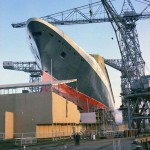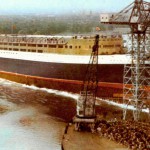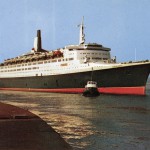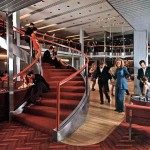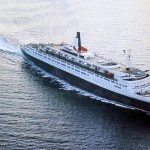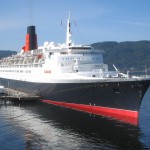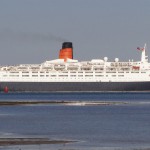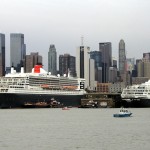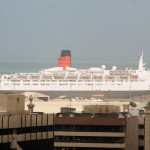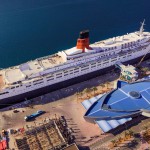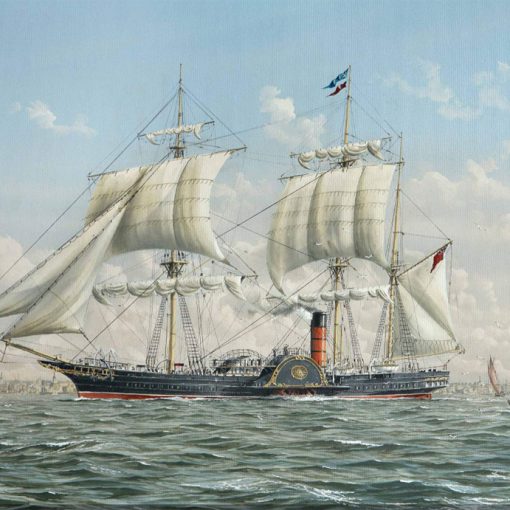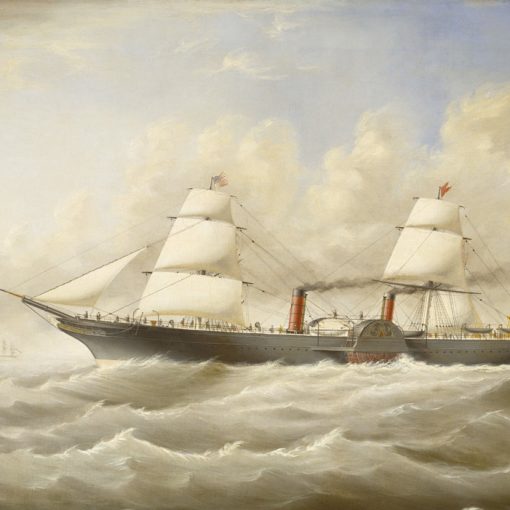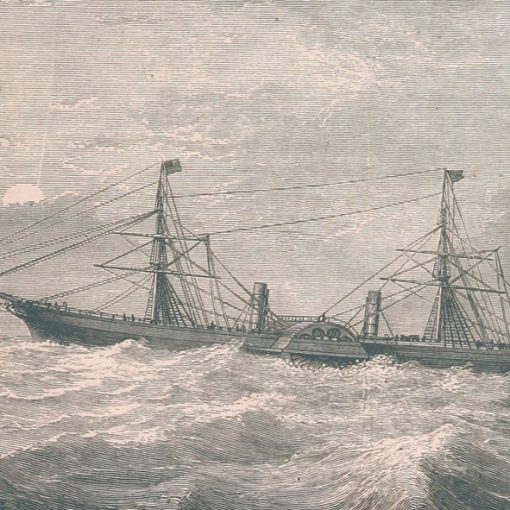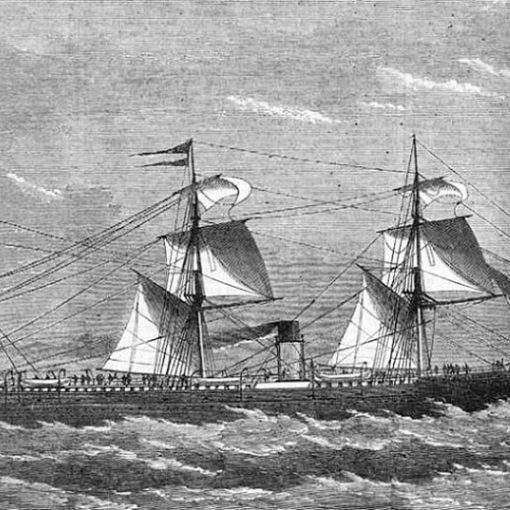1969 – Present Day
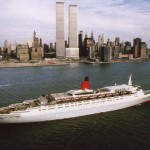
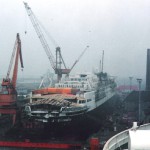
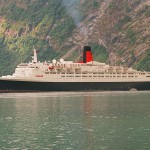
In the beginning of the 1970s, the quest for the North Atlantic did not stand between ships alone. The passenger airliner had since the end of World War II developed at a rapid pace, and was now swiftly conquering the globe. In spite of this, many ship owners were not worried. ‘Flying is but a fad. There will always be passengers for ships like the Queens.’ A director of the Cunard Line uttered these words in October 1958. Although time would prove him wrong, Cunard still saw business on the North Atlantic as profitable, and was planning to build a new vessel to replace the old Queen Mary at the Queen Elizabeth’s side.
The original plans called for a ship with classic lines and divided in three classes, intended for the transatlantic trade alone. This project, known as Q3 – The third Queen, was however soon abandoned. By 1965, 95 percent of those who crossed the Atlantic chose to do so by air. To launch a new ship for this route would be financial suicide. Naturally, Cunard realised this, and revised their plans for the new ship completely. The project, codenamed Q4, was underway. Cunard decided that the new ship would represent the ‘New Britain’ and therefore, they wanted lots of changes. This new vessel would not be divided into three classes, but in two – first and tourist – and the differences between these would be minor. The ship would be constructed so the two classes easily could be transformed into one for cruising arrangements; the ship would serve on the North Atlantic during summer and spend the winter months cruising in warmer waters.
The task of building the new Cunarder was given to the John Brown and Co. shipyards of Clydebank, the same company that had built and launched other great liners such as the two Queens and the Lusitania. On June 5th, 1965, the keel was laid on the same slipway that had once housed the Queen Mary during her construction. And like the Queen Mary, this new ship did not get a name until the day of her launch. She was simply known as ‘John Brown number 736’. While in the progress of breaking new grounds, Cunard was discussing to give the latest addition to their fleet a less traditional name. While names as ‘Great Britain’, ‘William Shakespeare’, ‘Winston Churchill’ and ‘London’ were mentioned, others opted for a more traditional name such as ‘Britannia’, ‘Mauretania’ or ‘Queen Mary II’. In the end, a decision was finally made. The new ship would be christened the Queen Elizabeth 2, to honour the previous Queen Elizabeth.
A little more than two years after her keel had been laid, the Queen Elizabeth 2 was christened and launched by Her Majesty Queen Elizabeth II on September 20th, 1967. By using the same pair of golden scissors as had been used on the launch of the previous Queens, the queen released the bottle of champagne and smashed it against the bow of the Cunard Line’s new flagship. Moments later, the great ship was afloat in the river Clyde, from then on popularly known as the QE2. Two days later, Queen Mary left New York harbour for her final transatlantic crossing.
Work proceeded swiftly on the new Cunard flagship. It was unmistakable that her design differed a lot from previous Cunarders, and this was certainly evident when one looked at her lone funnel. While in the process of breaking new grounds, it had been decided that the QE2’s funnel would not be painted in the famous Cunard orange and black colours. Instead, it was painted white.
In November 1968, the QE2 went through her sea trials. These couldn’t have turned out much worse. The ship suffered from serious problems with her turbines, and was forced to return to her builders for immediate inspection. Cunard refused delivery. Repairs were made, but soon other problems emerged and once again Cunard refused to take over the QE2. It is reasonable to assume that John Brown and Co. actually lost money in building the third Queen, and Cunard lost about ten million dollars when they were forced to cancel the scheduled maiden voyage, which was booked solid. But at last, in mid April 1969, the QE2 officially joined the Cunard fleet and departed from Southampton bound for New York on her maiden voyage on May 2nd.
Upon arrival in New York harbour, the QE2 received what now seems to be the last gala welcoming of a ship in New York. The interest was enormous, and all those who had the previous Queens still in memory wanted to catch a glimpse of their successor. But had Cunard been right to launch a new ship in these for ocean liners uncertain times? Only time would tell.
Time did tell. But at first, thing didn’t look at all bright. The last of the great Atlantic liners started to disappear one by one. By the end of 1969, the Blue Riband-champion United States was taken out of service and the last ship ever built for transatlantic crossings only – the France – was laid up in 1974. The two Italian liners Michelangelo and Raffaello went the following year, and there were rumours that the QE2 would be sent to the scrappers before her tenth birthday. Fortunately, this would not be the case. There were enough people who wanted the QE2 in service to secure the financial support. In 1975, Cunard sent their flagship on her first world cruise, and this was a promise of good times to come. The QE2 would survive.
Although connected with the two Queens by name, there were many things that made the QE2 different from her older sisters. Few ever thought that the new Queen would ever come to serve her country in times of war. Modern warfare seemed to manage quite well without requisitioning merchant vessels and instead using aeroplanes for transportation. But in 1982 something happened that proved that this was not the case. In April, Argentinian troops landed on the shores of the Falkland Islands. These islands, which lie in the South Atlantic off the coast of South America, are a British colony and Argentina had for many years claimed ownership of these isles because of their geographic location. Now, their patience was exhausted and they wanted ‘their’ islands back. The British were not prepared to give up one of the Empire’s last colonies and had to send military force into the area at once. A war was a very real threat and possibility.
However, the British quickly faced a serious problem. There were no friendly airstrips within a thousand miles of the Falklands. Any transportation would have to be done by sea. Things would have to be done like in the old days – by requisitioning ships from the country’s merchant fleet. The admiralty soon decided to go with two great liners, both capable of carrying thousands of troops each. These were the QE2 and the P&O Line’s Canberra. The ships were made ready, loaded with 3,000 troops and sent off to the area of the conflict on May 12th, 1982. However, the name that was written on the bows of the QE2 would protect her from immediate danger. If the ship bearing the monarch’s name was sunk, this would be very embarrassing for the British government. So the real dangerous task would be given to the Canberra. The QE2 was sent to South Georgia, about 1,500 miles (2,250 km) from Argentina. There her troops were transported to the Canberra, which would then carry them into the war zone. Nevertheless, the QE2 had served her country when she was needed, and this had secured her name in the history of the ocean liners. And almost as if they wanted to acknowledge her incredible heritage, Cunard now decided to repaint the ship’s funnel in the traditional Cunard colours.
The following years went by, with the QE2 sailing according to her regular schedule – Atlantic crossings in the summer and cruises during the winter. But during these years in the early 80s, the problems with her turbine engines once again began to surface. By 1986, Cunard decided that she would be refitted with a different type of engines, namely diesel-electric ones. The contract of performing this extensive refit was won by the West German shipyard at Bremerhaven. The work cost Cunard 162 million dollars, more than twice the amount it had cost to build the QE2. This may sound foolish by the Cunard Line to accept, but estimates showed that to build a new ship with similar capacity and speed would have cost the company 400 million dollars.
The following year, in 1987, the QE2 was back in service, not only with a brand new set of engines, but also sporting a new funnel of different design, the new stack being wider than the previous one. The refit seemed to have been exactly what the Queen needed. She was now both faster and more efficient than ever before. Later that year, she won The Queen’s Award for Export Achievement. Up until now, it seemed that the QE2 would live through a long career with no mishaps (if one does not count her turbine problems). But in August 1992, she had her taste of bad luck as well. While cruising in the Vineyard Sound off the coast of Massachusetts she ran aground, and damaged large parts of her keel and bow. Passengers were evacuated, and the QE2 were forced to go into dry dock for repairs costing Cunard Line great amounts of money. An investigation was soon underway. How could the QE2 have run aground in waters known to be deep enough for her? The answer came after serious investigation. The conclusion had been drawn and it was the so-called ‘squat-effect’ that was to blame. This phenomenon is created when larger vessels travel through water at higher speed. The shape and speed of the ship pushes the surrounding water away, literally digging a hole in the water for the ship. What was discovered during the QE2-investigation was that this effect was greatly increased while travelling at higher speeds, which the QE2 was doing at the moment of the grounding. The amount of water pushed away was simply larger than expected, and thereby the ship also had a lesser depth of water to sail in.
After this unnecessary and expensive accident, the QE2 was returned to service. However, in December 1994, Cunard took the opportunity to let her go through an extensive refit. Much work was made to renovate the relatively old ship, and bring her up to date on passenger comfort and safety regulations. Two years later, in 1996, another, yet not so extensive, refit was made and in 1999 some interiors were refurbished to meet new cruising standards. After thirty years in service, the QE2 looked a lot different to when she was launched. The aft end offered more deck space, and many changes had been made on her interior, including The Yacht Club-room and the Queen’s Grill.
The QE2 seemed to be the last of the true liners. In developing the new, huge cruise ships like the Destiny or Voyager of the Seas, it seems like something had been lost on the way. Amazingly, the Cunard Line, one of the first transatlantic shipping lines, had now become the last, even if the company was acquired by Carnival in 1998 and effectively became a niche venture of the cruising industry. In 2004, the QE2 was joined by a fantastic new fleet mate, namely the Queen Mary 2. This new Cunard flagship took over the trans-Atlantic duties, and Queen Elizabeth 2 was transferred to a full-time cruising schedule.
In September 2005, the QE2 officially became the longest-serving Cunarder, surpassing a record set by the Scythia. Having been with the company for so long, she seemed almost synonymous with the flag, and it was difficult to imagine a Cunard Line without her. But when the fleet was expanded with the new Queen Victoria, and new SOLAS regulations about to take effect in 2010, the time had finally come for Cunard to bid farewell to their long-time champion. In June 2007, it was announced that the ship had been purchased by the company Istithmar in Dubai for the sum of $100 million.
And so, the Queen Elizabeth 2 was sent on a farewell tour of sorts. In a ceremonial New York gathering, she met the Queen Mary 2 and Queen Victoria near the Statue of Liberty in January 2008, and later that year she toured the British Isles and Ireland as a goodbye to her homeland. She completed her final Atlantic crossing in tandem with the QM2, departing New York on October 16 and arriving in Southampton six days later. In that familiar port, the farewell celebrations continued, including a lengthy visit by Prince Philip, Duke of Edinburgh. Then, on November 11, 2008, she departed Southampton for the last time. She had 806 trans-Atlantic crossings under her belt, but she was now headed for a very different destination – Dubai.
When she arrived in her new country, she was given a splendid welcome. Once in Port Rashid, her last passengers disembarked, and the ship was moored in the port’s cargo area, to make way for other cruise ships at the passenger terminal. The plan was to refurbish the QE2 as permanently berthed luxury hotel and museum, but the economic crisis of 2008 forced her owners to shelve such plans indefinitely.
The ship laid dormant for a few months, until she moved – under her own power – into the Dubai Drydocks for inspection and refurbishment. Her owners announced plans that she would be going to Cape Town for use during the FIFA World Cup, but in January 2010 it was announced that such plans had been abandoned. Her owners simply issued a statement that ‘a number of options’ were being considered. Naturally, this led to some speculation as to what might happen with the Queen Elizabeth 2.
As if wanting to break free from her days in Limbo, the QE2 broke loose from her moorings in late January 2011, during a dust storm in the area. Although she drifted into the channel at Port Rashid, local pilots and tugs managed to bring the ship under control and back to her berth. There she remained throughout 2011 and 2012, with a skeleton crew and generating her own power. There were plans to try and bring her to Liverpool, but nothing came of this. Her owners claimed to have drawn up a new scheme of turning her into a hotel, and by the end of 2012 there were even reports of the ship having been sold for scrap. This, however, seemed unlikely since the sales contract with Cunard had included a “no onward sale” clause that would be in effect for 10 years.
So, the rumours continued. There were talks of the ship being brought to London to be docked near the O2 Arena, and others claimed that she was to be sent off to an Asian port to be used as a shopping mall. In Scotland, there were those who wanted to try and bring the QE2 home, with Greenock suggested as a possible location. But, as of early 2018, the ship remained in Port Rashid. At this point, her lifeboats have been removed and were stored at a car park near the ship’s location, and lifeboat davits that were installed in 1987 had reportedly been removed. The ship’s fate still seemed uncertain, but in the spring of 2018 she was taken into dry dock and was given a thorough touch-up. Rumblings about the QE2 being on the verge of opening as a floating hotel subsequently turned out to be true, and an official announcement was finally made in mid-April, 2018. Defying the dire predictions of many, the Queen Elizabeth 2 has once again proven to be a tenacious lady, and only time will tell if she will be profitable in her new role. She is, without doubt, a remarkable vessel and by now a living link to maritime days of old.



Specifications
- 963 feet (294 m) long
- 105 feet (32 m) wide
- 69,053 gross tons as originally built
- MAN medium speed turbo-charged diesel engines turning two five-bladed propellers
- 28.5 knot service speed
- Passenger capacity of 1,777 people

